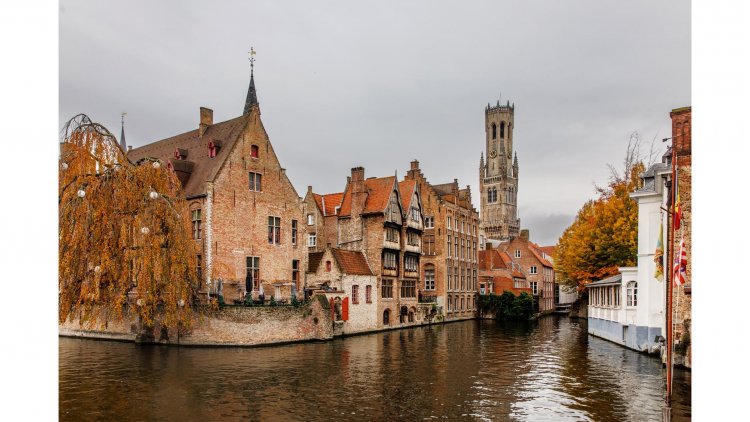A Journey Through Time: Unveiling Bruges’ Medieval Masterpieces
Bruges, Belgium, is a city steeped in enchantment, where the past feels palpably present in every cobblestone street and medieval façade. Known for its well-preserved architecture and charming canals, Bruges is a treasure trove of medieval artistry. As you traverse its winding alleys and serene waterways, you are not merely visiting a city but stepping back into a bygone era, a time when Bruges was a powerful trading hub and a center of artistic innovation. This guide will take you through the medieval marvels of Bruges, offering a glimpse into the city’s rich architectural heritage and the stories behind its most iconic structures.

The Belfry of Bruges: A Towering Symbol of Power and Prestige
The Belfry of Bruges, or the Belfort, stands as an imposing sentinel over the city, its silhouette unmistakable against the skyline. Constructed in the 13th century, this iconic bell tower is a testament to Bruges’ medieval prosperity and civic pride. Rising 83 meters high, the Belfry was not only a symbol of the city’s autonomy but also a crucial component of its defense system. The tower housed the city’s bells, which were used to announce important events and warnings of impending danger.
Visitors can climb the 366 steps of the Belfry for a breathtaking panoramic view of Bruges. The climb is a rewarding challenge, leading to a viewing platform that offers sweeping vistas of the city’s rooftops and spires. The bell mechanism itself is a marvel of medieval engineering, with 47 bells that still ring out across the city. Each bell has its own unique tone, and together they create a harmonious melody that has been part of Bruges’ soundscape for centuries.
The Belfry's architecture is a fine example of Gothic design, with its intricate brickwork and imposing height. The tower's base is fortified and square, while the upper levels are adorned with elaborate wooden spirework. The tower’s resilience against the test of time speaks volumes about the skill and craftsmanship of medieval builders. A visit to the Belfry is not just a historical journey but an immersive experience in medieval engineering and artistry.
The Basilica of the Holy Blood: A Sacred Jewel of Gothic Architecture
Nestled in the heart of Bruges, the Basilica of the Holy Blood is a revered shrine and a stunning example of Gothic architecture. The basilica is renowned for housing a vial of what is believed to be Christ’s blood, making it a significant pilgrimage site. The church’s architecture is a blend of Romanesque and Gothic styles, reflecting its long history of construction and renovation.
The Basilica of the Holy Blood consists of two distinct sections: the lower chapel, which is Romanesque, and the upper chapel, which is Gothic. The lower chapel, known as the Saint Basil’s Chapel, is characterized by its sturdy columns and semi-circular arches. It exudes a sense of medieval solidity and simplicity, with its original frescoes and sculptures offering a glimpse into the art and religious practices of the time.
In contrast, the upper chapel, or the Holy Blood Chapel, is a masterpiece of Gothic design. It features elaborate stained glass windows, intricate wooden carvings, and a splendidly decorated altar. The chapel's interior is adorned with rich tapestries and golden reliquaries, creating an atmosphere of opulent devotion. The Holy Blood itself is displayed in a richly decorated case and is the focal point of the basilica’s religious significance.
The basilica’s façade is equally impressive, with its ornate brickwork and towering spire. The Gothic elements are particularly evident in the intricate stonework and the detailed sculpture that adorns the entrance. The Basilica of the Holy Blood is not only a place of spiritual importance but also a remarkable example of medieval craftsmanship and artistic achievement.
The Market Square (Markt): The Heart of Medieval Bruges
The Market Square, or Markt, is the bustling heart of Bruges, surrounded by some of the city's most iconic medieval buildings. This vibrant square has been the center of Bruges’ civic and commercial life since the Middle Ages. Its historical significance is reflected in the architectural splendor of the surrounding buildings, each telling its own story of Bruges’ rich past.
Dominating the square is the impressive Guild Houses, which are a stunning example of Flemish Gothic architecture. These ornate buildings, with their elaborate gables and intricate stonework, were once the headquarters of various guilds that played a crucial role in the city’s trade and industry. Each guild house is distinct, showcasing unique architectural features and decorations that reflect the wealth and status of its respective guild.
The square is also home to the stunning Provincial Court, a grand neo-Gothic building that stands as a testament to the city’s continued importance in regional governance. The Provincial Court’s elaborate façade and intricate detailing make it a standout feature of the Market Square. The building’s design incorporates elements of medieval architecture, blending seamlessly with the older structures that surround it.
At the center of the square, the statue of Jan Breydel and Pieter de Coninck commemorates the leaders of the Bruges Matins, a revolt against French rule in the 13th century. This statue is a symbol of Bruges’ defiant spirit and its rich history of resistance and independence. The Market Square itself is a lively place, often hosting events, markets, and festivals that continue the tradition of civic gatherings that have been a part of Bruges’ history for centuries.
The Beguinage (Begijnhof): A Tranquil Refuge of Medieval Serenity
The Beguinage, or Begijnhof, is a serene enclave in Bruges that offers a glimpse into the lives of the medieval Beguines, a group of lay religious women who lived a communal, pious life. This tranquil retreat is a remarkable example of medieval social and architectural harmony, with its neatly arranged houses, peaceful courtyards, and serene atmosphere.
Founded in the 13th century, the Beguinage was designed as a self-contained community where Beguines could live a life dedicated to service and prayer while remaining independent from traditional monastic life. The architecture of the Beguinage is characterized by its simple yet elegant design, with white-washed houses, cobblestone streets, and peaceful gardens.
The central courtyard of the Beguinage is a focal point of tranquility, with its well-maintained gardens and historic buildings. The houses are arranged around this central space, creating a sense of order and calm. The Beguinage’s architecture reflects the medieval ideals of simplicity and functionality, with practical, unadorned buildings that serve the needs of their inhabitants.
Visitors to the Beguinage can wander through its peaceful streets, admire the well-preserved medieval architecture, and gain insight into the lives of the Beguines. The Beguinage is a UNESCO World Heritage Site, recognized for its historical and cultural significance. It provides a unique opportunity to experience a quieter, more contemplative side of medieval Bruges, away from the bustling city center.
The Church of Our Lady (Onze-Lieve-Vrouwekerk): A Beacon of Medieval Artistry
The Church of Our Lady, or Onze-Lieve-Vrouwekerk, is one of Bruges' most monumental and significant landmarks. This Gothic masterpiece, constructed between the 13th and 15th centuries, is renowned for its stunning architecture and its invaluable art treasures. The church stands as a testament to Bruges' historical importance as a center of art and culture during the medieval period.
The church’s exterior is characterized by its slender, vertical lines and towering spire, which rises to 115 meters, making it the tallest brick building in the world. The façade, though relatively austere compared to the interior, is punctuated by intricate detailing and ornate stonework that highlight the Gothic style’s emphasis on verticality and light.
Inside, the Church of Our Lady is a veritable gallery of medieval art and architecture. The nave is adorned with elegant ribbed vaults and soaring columns that create a sense of upward movement and grandeur. One of the church’s most famous treasures is the marble sculpture of the Madonna and Child by Michelangelo. This Renaissance masterpiece, which was brought to Bruges in the early 16th century, stands out amidst the Gothic surroundings with its serene beauty and intricate detail.
The church also houses a wealth of other art and historical artifacts, including an impressive collection of medieval tombs and stained glass windows. The tombs of Charles the Bold, Duke of Burgundy, and his daughter Mary of Burgundy are particularly noteworthy. Their elaborate monuments reflect the significance of these figures in Bruges' history and the grandeur of their legacy.
The Church of Our Lady is not just a site of historical and artistic interest but also a vibrant place of worship. Its continuing role as a spiritual center connects visitors to the living traditions of medieval Bruges, making it a must-visit for anyone interested in the city’s rich cultural and religious heritage.
The Gruuthuse Museum: A Window into Medieval Domestic Life
The Gruuthuse Museum, housed in a 15th-century mansion, offers a fascinating glimpse into the domestic life of medieval Bruges. Once the residence of the wealthy Gruuthuse family, this museum provides an immersive experience into the opulent lifestyle of Bruges’ elite during the Middle Ages.
The mansion itself is a masterpiece of medieval architecture, featuring a blend of Gothic and Renaissance styles. Its ornate façade and elaborate interiors reflect the wealth and status of its original inhabitants. Inside, the museum’s exhibits showcase a range of artifacts that illuminate various aspects of medieval life, including furniture, textiles, and domestic objects.
One of the museum’s highlights is its collection of medieval tapestries, which are not only visually stunning but also provide insights into the themes and stories that were important to medieval society. The tapestries are meticulously crafted, with intricate designs and rich colors that exemplify the high level of craftsmanship achieved during this period.
In addition to tapestries, the museum’s collection includes fine ceramics, jewelry, and weaponry, offering a comprehensive overview of the material culture of medieval Bruges. The museum also features reconstructions of historical rooms, such as a medieval kitchen and a noble’s chamber, allowing visitors to experience firsthand the living conditions of the time.
The Gruuthuse Museum stands as a testament to the rich cultural heritage of Bruges and provides valuable context to the city’s architectural and artistic achievements. Its collection helps bridge the gap between the grand public buildings and the private, domestic spaces of medieval Bruges, offering a complete picture of life in this historic city.
The Bruges City Hall (Stadhuis): A Gothic Gem of Civic Architecture
The Bruges City Hall, or Stadhuis, is a quintessential example of Gothic civic architecture and an important symbol of the city's medieval governance. Located on Burg Square, this grand building has been the seat of Bruges’ municipal administration since the 14th century and continues to play a role in the city’s public life.
The City Hall’s façade is a striking example of Gothic design, with its elaborate brickwork, pointed arches, and intricate stone carvings. The building’s exterior is adorned with statues of various historical figures and saints, each contributing to the rich narrative of Bruges’ history and civic pride.
Inside, the City Hall boasts a beautifully decorated interior that includes the impressive Gothic Hall. This vast space is characterized by its high vaulted ceiling, colorful stained glass windows, and detailed woodwork. The hall’s ornate design and grand proportions reflect the importance of civic functions and ceremonies held within its walls.
The City Hall also features a collection of historical artifacts and paintings that depict key moments in Bruges’ history. These artworks offer insight into the city’s development and the significant events that have shaped its past. The building’s historical significance is further highlighted by its role in various civic events and ceremonies, maintaining its connection to the city’s heritage.
A visit to the Bruges City Hall provides not only a chance to admire its architectural beauty but also an opportunity to understand the city’s medieval governance and public life. Its place on Burg Square, alongside other historic buildings, underscores the central role of civic architecture in shaping Bruges’ identity and heritage.
The Lake of Love (Minnewater): A Medieval Enchantment Amidst Nature
The Lake of Love, or Minnewater, is a serene and picturesque spot in Bruges that offers a different perspective on the city’s medieval charm. While not a building, the lake and its surrounding park are deeply intertwined with Bruges’ history and provide a tranquil escape from the bustling city center.
Legend has it that the lake’s name derives from a tragic love story, adding a layer of romance and mystique to the area. According to local folklore, the lake was named after Minna, a young woman who drowned herself in despair over a lost love. This story adds an enchanting element to the lake’s natural beauty and historical significance.
The Lake of Love is surrounded by lush greenery and historic buildings, including the picturesque Beguinage and the imposing city walls. The lake’s calm waters, reflected in the setting sun, create a peaceful and idyllic atmosphere that contrasts with the lively streets of medieval Bruges.
Visitors to the Lake of Love can enjoy leisurely strolls along its banks, take in the scenic views, and explore the surrounding parkland. The area is also home to a charming stone bridge, which adds to the lake’s picturesque quality and provides a perfect spot for photographs.
The Lake of Love is a testament to the way natural beauty and historical architecture can coexist, offering a serene retreat that complements Bruges’ rich medieval heritage. Its enchanting ambiance makes it a must-visit destination for anyone seeking to experience a different facet of the city’s charm.
Bruges’ medieval architecture is a testament to its rich and varied history, offering a fascinating journey through time. From towering belfries and sacred basilicas to tranquil beguinages and elegant city halls, each structure tells a story of Bruges’ past and its enduring legacy. Exploring these architectural marvels provides not only a glimpse into the city’s history but also an appreciation for the artistry and craftsmanship that defined its medieval era. As you wander through Bruges, you are walking through a living museum of medieval architecture, where every building and street corner reveals a piece of the city’s storied past.
Disclaimer: The travel information and recommendations on this blog are intended for general guidance and inspiration. Conditions and regulations can change quickly, so please verify all details with appropriate sources before making travel plans. We are not liable for any errors, omissions, or outcomes resulting from your use of this information. Travel involves inherent risks, and it's essential to prioritize your safety and well-being. Always travel with adequate insurance and take necessary precautions.
What's Your Reaction?





















